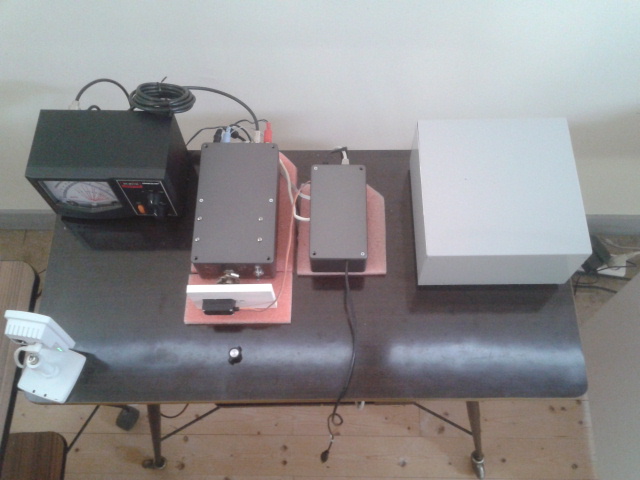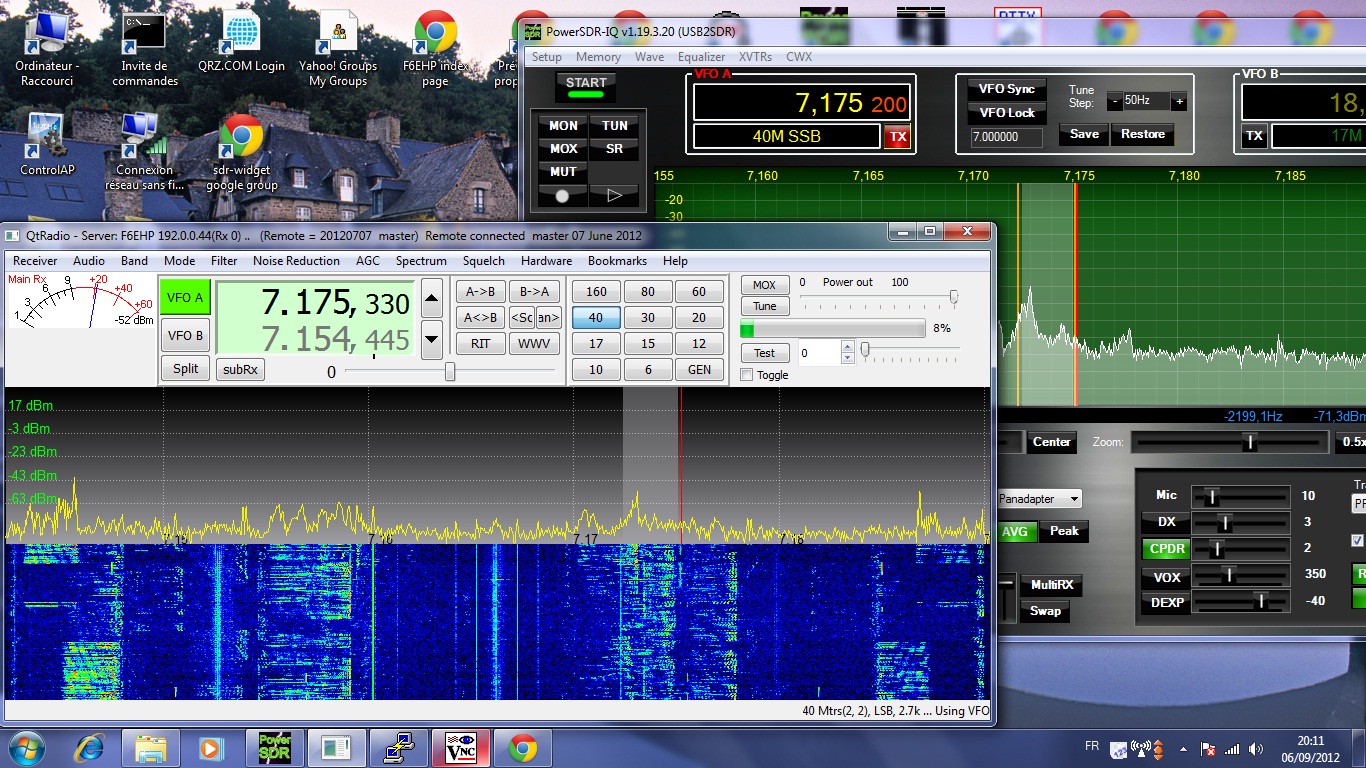a remote SDR station with ghpsdr3-alex server
& the softrock 6.3 hardware
Since a long time, I was dreaming to build a remote station controlled from my usual shack, at home, where antennas cannot be excellent on all the bands. Looking on internet, I wanted to find an inexpensive solution, using the parts I have and my little know-how. I found one interesting idea to f6ghg setup (look at qrz.com), but using a too much complicated hardware. With my softrock TX/RX, i tried to use it remotly with logmein + IPsound then with teamviewer as a remote control, but these softwares are really not friendly solutions.
Then I found on internet the hpsdr
group designer of a client/server project for SDR hardware, and
the release made by Alex seems really the right solution:
http://napan.ca/ghpsdr3/index.php/Main_Page
The server works on linux only, and the client called QtRadio can work on linux as well as on windows.
To be honest, as a linux newbie,
the only think I could start by myself is the windows client.
Installing the Qt and the server on my Ubuntu 12.04 release is
not a job for any beginner. I recommand to any people who wants
to try, first to read the links and to subscribe on the google
group hereunder to find the necessary help. So, i will not give
complete details here. Releases are updated every day, the authors
works hard on the project, and of course do not warranty
anything.
http://groups.google.com/group/sdr-widget
| REMOTE
STATION : a computer with linux Ubuntu 12.04, E-MU
202 audio usb card used as IQ input/output for the
Softrock 6.3 (with a 10 W amplifier and filters) - all
these units are powered through an IP switch 9258 from
"ip power", in order to be able to switch off all
the remote station in case of failure.
I also have a webcam looking at the swr meter on the automatic tuner. |
|
| LOCAL STATION
: any windows computer with a headset and connected
to internet or to the remote through a local network. When
operating the remote station, I need to open a QtRadio
client, to connect it on the server, to open a browser with
the webcam , and also to be ready to switch off the rig if
necessary, with a vnc client connected on the server, ...and
also in case of big trouble..., a browser connected on the
ip switch to power off all the sets, softrock and computer
included ! |
|
Odroid-X card is a small complete computer card working on Android or on Linux Ubuntu Linaro. I have choosen this last OS for which we can find a ready to use image on the web to burn in a SD-card.
Odroid products are sold by Hardkernel which ships from Korea usually in 10 days (add 30% taxes in Europe) - Since I ordered the -X version, other cheapper units have been developped and offered on the market like -U2, or -X2. See complete specifications on the builder site. Avoid to use the LCD unit , or find another power supply, as the one supplied with it will give a high level of noise in the radio. I always control the Odroid through a ssh server and putty client from another computer on the LAN. Also x11vnc can be use with a ssh connexion.
Ubuntu image for the ODROID can be found from these locations ODROID forum or from this mirror - After burning the image on the SD-card, you have to come back to the ghpSDR wiki, in order to install all the necessary softwares .
I have written this how_to_build_notes to report the necessary steps to build ghpSDR3-Alex on an ODROID-U2 or -X2 from scratch. I had a lot of issues with the -U2, and recommand to use the -X2. Usefull for newbies, useless for the guys who can swim in the linux ocean...
But, for the one who are not familiar with these steps, I have done two complete ready to use images of my own SD-cards ( reduced size for a 16Gb SD-Card ) :
ODROID-X : Oct 2013: Last Image made from my ODROID-X card Download from here ( 2.2Gb zipped (xx.img.tar.gz) file from my own server - it may require a few hours to download it !) - Dowload the updated how_to_run_notes - Made in June 2013 with the a Linaro Ubuntu 12.11 and the 3.0.60 Kernel provided by the official source Hardkernel ( all devices working ) Including ghpSDR-3 Master branch by Alex , and the QUISK 3.6.13 software from James Ahlstrom. ( QUISK works very well, but doesn't control the station as a remote ) see my Note on Quisk -
So, you can use any softrock I/Q hardware or other unit, with a usb sound card as the E-MU202 or similar for I/Q. The local input and output sound can be used for mic and phone or better, use an usb headset if you wish to run QtRadio or QUISK on the card. I prefer to use a windows QtRadio on another unit on the LAN or through a wifi link. -- screencopy1 (fdisk & lsusb) & screencopy2 (xterminals with servers started).
ODROID-U2 : May 2013: Image of the ODROID-U2 micro SD-Card ( 16 Gb ) Download from here. (3Gb zipped) Warning : this setup doesn't allow to run QtRadio client and dspserver at the same time because of the sound setup mixed with the hdmi output...This release is updated at end of May 2013 running also with a Linaro Ubuntu 12.11, kernel 3.0.75 from Hardkernel, wifi activated. > how_to_run_notes
See why I use an usb E-MU202 instead of the integrated sound device for I/Q - screencopy with E-MU, screencopy without.
Next step ( done ! ) is to remote control the LPF after the 10W amp, which is a manual K5OOR filter, with an Arduino ethernet control board and...a ....servomotor ! This second unit (web interface) will do all the auxiliary jobs - Arduino is much more easy to learn than the ugly couple linux+"c" when you don't need realtime and calculation as we need for audio treatments.
Arduino family - Drawing -
software
code -photo of the web
interface - photo
of the servo that has replaced the button !- super ! 2 hours only to get a code ready to work !
Take care to supply the servo through a direct line with a 5V
regulator from your 9V power supply with enough capacitor filtering
( 50 MF)
Second step ( done ! ) will be to add a remote controlled BPF ( from WB6DHW
)to improve rejection on the RX, as the one provided with the 6.3
Softrock is really wide range ( 18 Mhz !wide from 7Mhz to 24 Mhz)
Last step (may be end of 2013 !!) is to add a Ten-Tec 1210 2m transverter, a 25W amp a bigwheel antenna, also a 1208 transverter for 6m , using the 2m mast as a J-Pole 6m antenna. Guys of this mast will be half-waves dipoles for 20m and 40m !
Other websites to visit : w3sz n8mdp (usbsoftrock & quisk) - also in french, the nice "hitchhiker's guide to ghpsdr3-alex's installation, French unabridged edition" by F6ITU on http://wiki.electrolab.fr/Projets:Lab:2011:GHPSDR3-Alex

the complete REMOTE station ( pdf)
E-MU202 usb sound card and the ODROID-X (or -U2) are inside a shelded box to avoid radio interference when TX is on. (on the right) - A small fan has been added to secure the CPU.
The Arduino control card is in the small grey box
Softrock 6.3 with WB6DHW BPF and the10W + LPF are in the grey box in the left side.
Notice the SWR-Wattmeter, controlled by an IP webcam.
|
Results:
easy to use when
the configuration is done !... I got
good reports on the first qso with european stations on
17m, 20m & 40m.
I will soon use it with a 2m transverter to improve the
performances on this band, as from my home my antenna gives
poor results due to the hill on which my house is built.
|
NOTES for softrock users: - be aware to invert IQ connexion on TX side, compared with PM-SDR configuration - see the google group for that. - On QtRadio client, try to connect or disconnect IQ correction in the DSP windows and keep the best position. |
 |
||
See on the same screen, the Qt client connected on my remote Softrock through a private wi-fi link - half a mile away -(internet link is forbidden in France), and the local FA-SDR with USB2SDR working to my home, on the same 40 m frequency. Softrock antenna was poor compared to my inverted V at home, that explains the smaller signal on the remote. Delay between the remote and the local is around half a second.
Now using a double inverted V
dipole for 40m & 20m, and a CobWeb antenna for 17m to 10m bands.
a nice map of all the servers connected in the world - http://www.montefusco.com/ghpsdr3/
see also the great site of N8MDP with his "jmonitor"